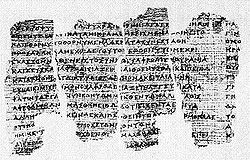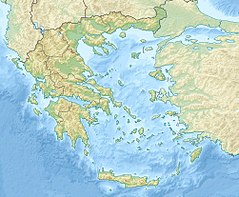
Back Дервентски папирус Bulgarian Papir de Derveni Catalan Papyrus z Derveni Czech Derveni-Papyrus German Πάπυρος του Δερβενίου Greek Papiruso de Derveni Esperanto Papiro de Derveni Spanish پاپیروس دروینی Persian Dervénin papyrus Finnish Papyrus de Derveni French
| Derveni papyrus | |
|---|---|
| Archaeological Museum of Thessaloniki | |
 Some fragments of the Derveni papyrus | |
| Type | Papyrus roll |
| Date | c. 340 BC, from an end-5th century BC original |
| Place of origin | Macedon |
| Language(s) | Ancient Greek, mixed dialects |
| Material | Papyrus |
| Size | 266 fragments |
| Format | 26 columns |
| Condition | Fragmentary, charred from funeral pyre |
| Contents | Commentary on a hexameter poem ascribed to Orpheus |
| Discovered | 1962 |
The Derveni papyrus is an ancient Greek papyrus roll that was found in 1962. It is a philosophical treatise that is an allegorical commentary on an Orphic poem, a theogony concerning the birth of the gods, produced in the circle of the philosopher Anaxagoras. The roll dates to around 340 BC, during the reign of Philip II of Macedon, making it Europe's oldest surviving manuscript.[1][2] The poem itself was composed near the end of the 5th century BC,[3] and "in the fields of Greek religion, the sophistic movement, early philosophy, and the origins of literary criticism it is unquestionably the most important textual discovery of the 20th century."[4] While interim editions and translations were published over the subsequent years, the manuscript as a whole was finally published in 2006.
- ^ "Ancient scroll may yield religious secrets". Associated Press. Retrieved 1 June 2006.
- ^ "THE PAPYRUS OF DERVENI". Hellenic Ministry of Culture. Archived from the original on 28 April 2006. Retrieved 1 June 2006.
- ^ "The Derveni Papyrus: An Interdisciplinary Research Project". Harvard University, Center for Hellenic Studies. 2 November 2020. Archived from the original on 30 July 2017. Retrieved 24 May 2015.
- ^ Janko, Richard (2002). "The Derveni Papyrus: An Interim Text". Zeitschrift für Papyrologie und Epigraphik. 141: 1–62. ISSN 0084-5388. JSTOR 20191519.
© MMXXIII Rich X Search. We shall prevail. All rights reserved. Rich X Search
